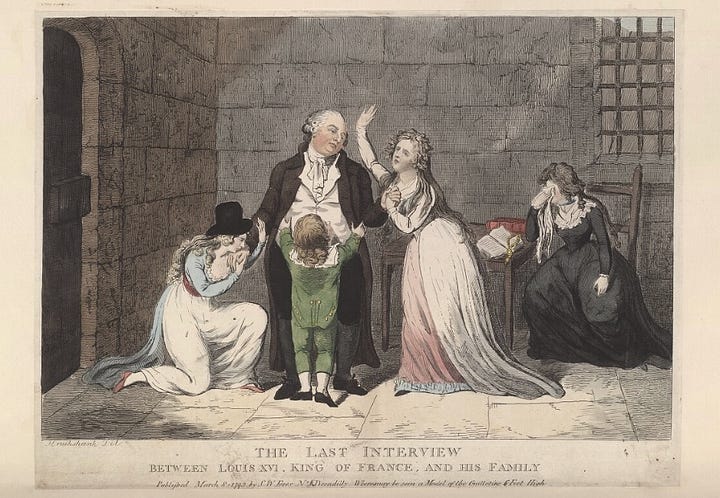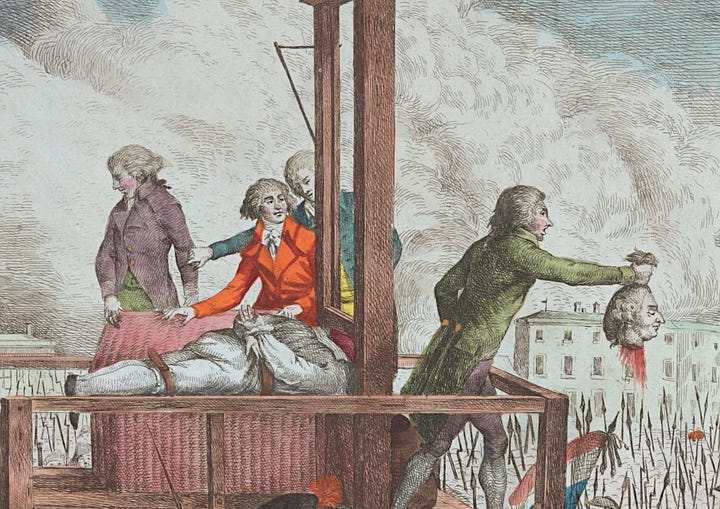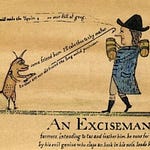The end of Mile Marker 2, as well as our story of Lapérouse and Ledyard.
/ 11° 39′ 0″ S, 166° 54′ 0″ E
/ sources and transcript of this episode at our website
/ @gototheroots: instagram | bluesky | linktree
/ support the podcast: patreon | ko-fi | subscribe to the substack
/ intro/outro music by aldous ichnite — “You'll Have a Plan Before You Try to Get Your Horse on the Trailer” and “Our Entire Bodies Have Always Been the Most Powerful Form of Visual Expression”
/ additional music by Telecasted | Quincas Moreira
If Billings, or Sauer, did know anything of Ledyard’s arrest – would they have told Jean-Baptiste Barthélemy de Lesseps when he arrived and shared a meal?
Lesseps left Lapérouse – or, Lapérouse left Lesseps in October 1787 – and it took him to May 1788 to reach Okhotsk, which was Ledyard’s final destination in Russia as well as where Billings’ two ships were being built for his expedition (as he’d set sail in September of ’89). He reached Yakutsk and prepared to sail up the Lena River in July 1788 – six months after Ledyard got on the river, five months from his arrest.
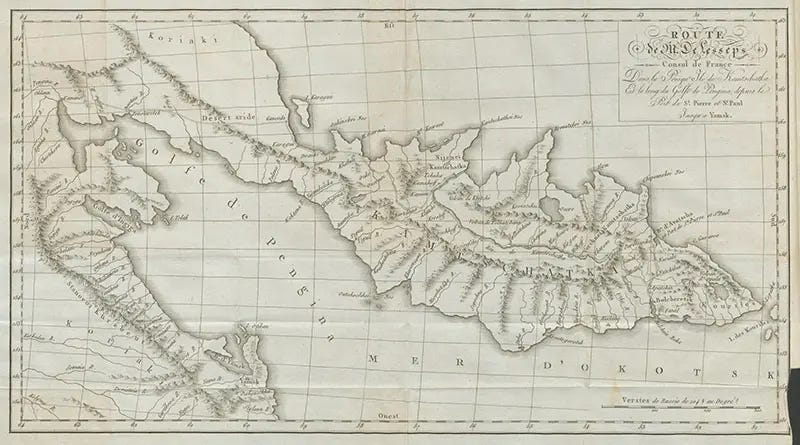
Somewhere in this timeframe, he met with Billings, though Lesseps wasn’t too sure of his expedition’s complete instructions guessing it was “either to go exploring through the Bering Strait or to expand Russian claims down the coast of America” (and Billings likely saw Lesseps as a rival of some sort).
From Irkutsk, he traveled by carriage (much like Ledyard) over the Urals and pushed hard (through injury) to avoid winter, reaching St. Petersburg on September 22, 1788, “having travelled six-thousand versts [roughly a verst is 3,500 ft] in forty days, eight of which were lost in unavoidable delays.”1
He delivered the charts, maps, correspondence successfully, but was invited to meet with Louis XVI – arriving in Paris on October 17. Afterwards, he’d receive a job with his father in Russia – and his stint in the country buffered him from the Terror and, under Napoleon, who could’ve well been his shipmate on Lapérouse’s fateful journey, he’d be tasked with rebuilding diplomatic relations, before he’d invade Russia in 1812 and ruin them again.
But throughout the years, from the revolutionary summer, then beyond – forty, to exact – he’d await news of Lapérouse. “How cruel for me, after a year of impatient expectation, to see the wished-for period still more distant!” he’d write in his published voyages. “Not a day has passed since my arrival, on which my wishes have not recalled the Astrolabe and Boussole.”
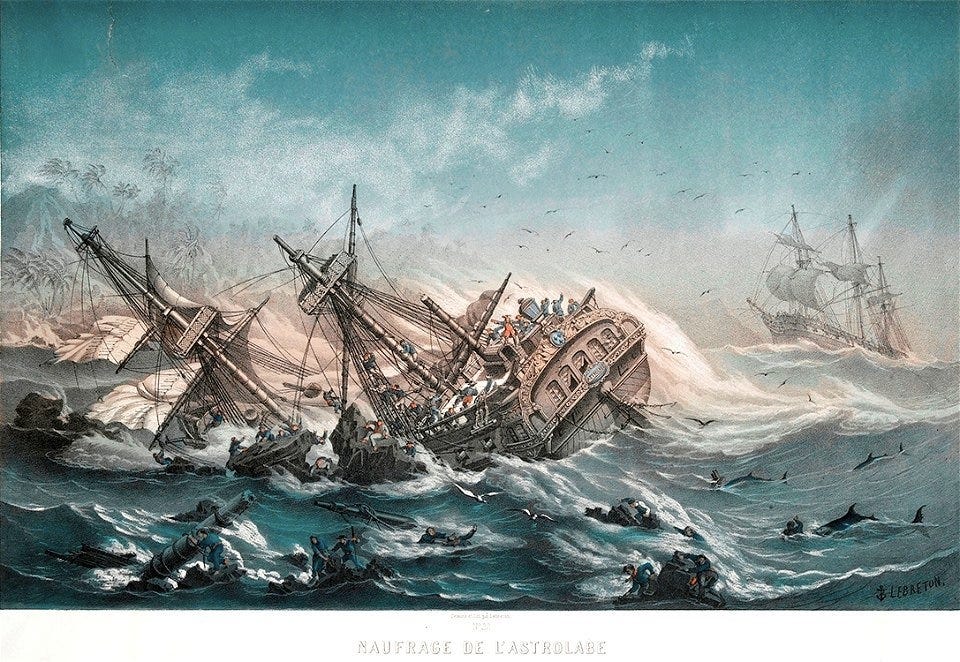
In 1828, he’d be asked to positively recall fragments (“the memorials” as he called them) of the Astrolabe, brought back by Peter Dillon (of the St. Patrick), confirmed by Captain Dumont d'Urville (of, fittingly, the Astrolabe).
Dillon and d’Urville weren’t the first to search for Lapérouse – though as their working knowledge of his voyage ended in Australia – the Pacific is quite an ask to explore for a two ships.
Three weeks before the Day of Daggers in early February 1791, where nobles attempted to fight the National Guard, perhaps to help the beleaguered King escape Paris (which he’d attempt that summer), the Constituent Assembly voted on a request from the Society of Natural History to investigate the fate of Lapérouse. It would pass and in time a ship – beleaguered by many issues, political affiliations being only of them – would be unsuccessful in locating any trace of Lapérouse, despite circling the area and sailing by Vanikoro, in the Solomon Islands, where Dillon would hear of in 1826 before procuring a boat two years later.
However, if there were any survivors (which there probably were), the French tricolor would’ve been unfamiliar (though, I’m not sure they wouldn’t have tried out of sheer desperation). Especially after the HMS Pandora, piloted by notorious asshole Edward Edwards, who, in 1791, while searching for the mutineers of the infamous HMS Bounty, charted Vanikoro and wrote:
While cruising sometimes at less than a mile from the reef, we didn't see any houses or inhabitants. Nevertheless we perceived a very thick smoke indicating that in fact the island could have been inhabited.
Edwards had no interest in this clear distress signal – believing no mutineer would be advertising their position. He sailed on – well, sailed into the Great Barrier Reef where 35 of his men died, though not Edwards.
It would take 40 years, and Australia to become a reliable port with supplies for government and commercial ships, for accumulated stories of sightings of European swords and teacups and medals to coalesce into one location. Vanikoro is an island – really a series of islands – surrounded by a belt of coral reef and, upon both crew’s travails with its reefs and currents, Dillon (then d’Urville) was able to construct Lapérouse’s final moments – though there is no way to fully know.
It’s generally accepted that the Boussole wrecked first, followed by the Astrolabe. In the confusion, those first off the Boussole, likely, were attacked and killed by the local inhabitants (if not eaten by sharks, as the locals contended). Survivors from the accident spent months building a boat out of the wreckage with the intention of sailing west (the locals saying some did, though two men stayed behind). If that boat ever left the harbor – the French camp was right across from a break in the reef that, surely, they’d’ve shot for as sounding and charting would’ve been dangerous and after this disaster (and Lituya Bay), their nerves were undoubtedly fried. It appears they had little contact with the local population after the initial encounter – and if they remained for months, its a wonder if more didn’t die of malnutrition, if not starvation or disease.
While the Boussole was found in 1964 (and confirmed with new technology in 2005), any remnant of the boat crafted to free them from Vanikoro has never been found.
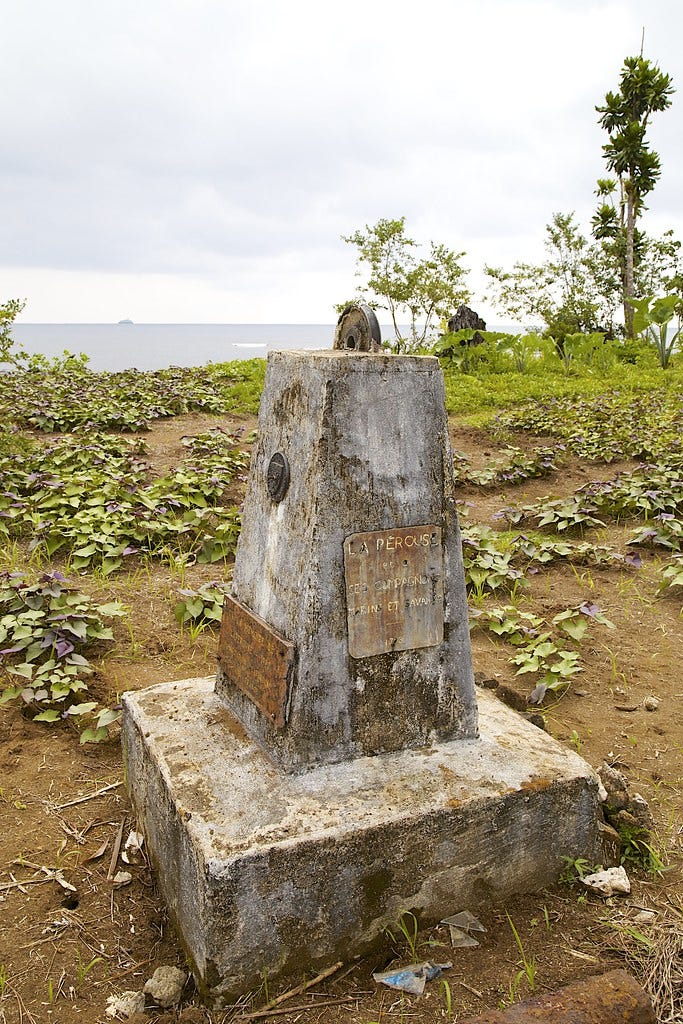
As the men of the Lapérouse expedition eeked out what was to be the final months of their lives, John Ledyard returned to London in spring of ’88 and was drafted into his adventure, and the next colonial preoccupation of Europe: exploring Africa.
Ledyard would meet the representative for Association for Promoting the Discovery of the interior Parts of Africa in Paris that July. Having come recommended by Joseph Banks, the representative was “struck with the manliness of his person, the breadth of his chest, the openness of his countenance, and the inquietude of his eye.” Ledyard would afterward meet with Jefferson, who got a few jabs at his joining “an English Association” but provided him with the same letters of introduction as he’d done for Catherine and Russia.
Despite all that, it wouldn’t be a Ledyard expedition without him lacking the proper paperwork for passage from France to North Africa (and Jefferson apologizing for his being “a different kind of person”).
Ledyard’s optimism and boundless spirit is, as a reader, and a traveler, one of the most infectious elements of his prose — one of my favorites, “I am determined to sit down, not despondingly, dejectedly, or supinely—what a vile row of adverbs—but contemplatively, cheerily, and industriously. It seems decreed by somewhat, that I shall be driven about the world in a most untraversable way; but in whatever clime I may alight, my ardent desire is, that the friendship of my friends may greet me well” — but there’s something about the final letters of his life that feel homesick.
He’d written prior to leaving for Egypt,
Do not think, because I have seen much of the world, and must see more, that I have forgotten America. I could as soon forget you, myself, my God.
But, as the great Touché Amoré sing: “It’s just I have this problem where I wanna be everywhere I’m not.” Thus, Alexandria was a wretched town and Cairo a cesspool. In September, he asks Jefferson if he knew of the Connecticut River – cause if you’ve seen that, you’ve seen the Nile. (“This is the mighty the sovereign of rivers—the vast nile, that has been metaphored into one of the wonders of the world—let me be carefull how I read—and above all how I read Antient history!”) As for the weather: “I think I have felt it hotter at Philadelphia in the same month.”
In November, he writes what is believed to be his final letter on earth: he misses Lafayette, who is busy with the tumult that is about to envelope France; he advises Jefferson to burn his histories “Without entering into a discussion, that would be too long for a letter, I cannot tell you why I think most historians have written more to satisfy themselves, than to benefit others”; he has a final word on the disagreeability of religion; and assures Jefferson “that even your curiosity and love of antiquity would not detain you in Egypt three months.”
He closes with one last paean to twin flames of his adventurous life: “lonesomeness” and “fate”:
From Cairo I am to travel southwest about three hundred leagues to a black king. Then my present conductors will leave me to my fate. Beyond, I suppose I shall go alone.
But if Jefferson doesn’t hear from him – and it’s clear Ledyard wants to be heard by him more than anyone (save Lafayette),
do not forget me in the interval of time, which may pass during my voyage from thence to Europe, and as likely to France as anywhere. I shall not forget you; indeed, it will be a consolation to think of you in my last moments. Be happy.
John Ledyard died somewhere in North Africa. Joseph Banks wrote Tom Paine (of Common Sense fame and member of the Royal Society,
We have lost poor Ledyard… he had agreed with certain Moors to conduct him to Sennar. The time for their departure was arrived when he found himself ill and took a large dose of emetic tartar, burst a blood vessel on the operation which carried him off in three days.
Jefferson couldn’t have been shocked, but his wish from years ago – “I shall never wish to die while you and the Marquis are alive” – would, like so much, remain unfulfilled.
“If he succeeds, and in the course of two or three years should visit our country by this amazing circuit” Col. William Smith wrote to John Jay on the prospect, slim as it was, that Ledyard could cross Siberia and walk across America, “he may bring with him some interesting information. If he fails, and is never heard of more, which I think most probable, there is no harm done. He dies in an unknown country, and if he composes himself in his last moments with the reflection, that his project was great, and the undertaking what few men, are capable of, it will to his mind soothe the passage.”
Of that, we cannot know, but Sparks relates,
The best medical skill in Cairo was called to his aid without effect, and he closed his life of vicissitude and toil, at the moment when he imagined his severest cares were over, and the prospects before him were more flattering, than they had been at any former period.
“What eyes do travellers see with—are they fools, or rogues,” Ledyard asked Jefferson, who sailed out of France in September 1789.
Prior to leaving, almost anticipatorily [is that word?], Jefferson wrote about Ledyard to James Madison (not that James Madison, the Reverend in Williamsburg). It’s as concise as we get from Jefferson, a story that’s taken me ten entries:
A country man of ours, a Mr. Lediard of Connecticut set out from hence some time ago for St. Petersburgh, to go thence to Kamschatka, thence to cross over to the Western coast of America, and penetrate through the continent to our side of it. He had got within a few days journey of Kamschatka, when he was arrested by order of the empress of Russia, sent back and turned adrift in Poland. He went to London, engaged under the auspices of a private society formed there for pushing discoveries into Africa, passed by this place, which he left a few days ago for Marseilles, where he will embark for Alexandria and Grand Cairo, thence explore the Nile to it’s source, cross to the head of the Niger, and descend that to it’s mouth.
He ends the paragraph tantalizingly, for us:
He promises me, if he escapes through this journey, he will go to Kentuckey and endeavour to penetrate Westwardly from thence to the South sea.
No doubt they’d discussed this back in 1785 – Jefferson telling him of asking George Rogers Clark – and perhaps Jefferson raised the prospect of such a journey again, perhaps that’s where the ribbing for joining another English endeavor came from.
The major obstacle, which for Jefferson and Ledyard both, was the lack of money and power to truly do it right. “Money! it is a vile slave!” he could write to the African Association, despite seeing literal slave markets in Egypt. Yet the point stands, meekly.
As Jefferson sailed home, knowing Ledyard’s demise was true, he couldn’t have known the next candidate was already in America, “botanizing” for France. Roughly three years later, on January 20, 1793, this man, André Michaux, presented his Observations on Proposed Western Expedition to the American Philosophical Society.
As Thomas Jefferson (Secretary of State) finalized for Michaux his first set of instructions, based upon the wealth of geographic knowledge we’ve looked at so far, and the APS itself double-checked their subscription list with the names of Washington, Hamilton, Madison, Adams, King, Mifflin, Trumbull, and Morris, among others, no one could’ve known that following day, January 21, 1793, the King of France, Louis XVI, would be guillotined.
That morning, as he woke to take his confession and last rites, and said goodbye to his family, he asked those assigned to him,
Any news of La Pérouse?
